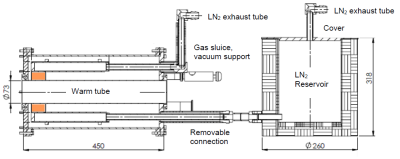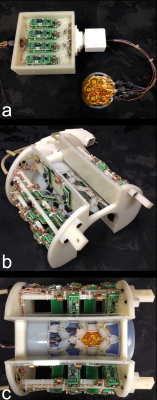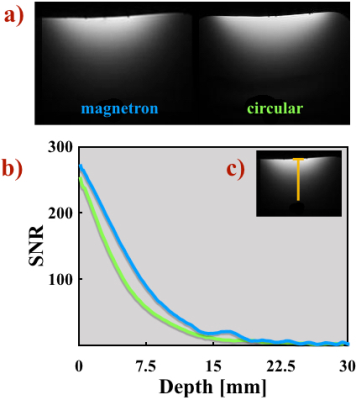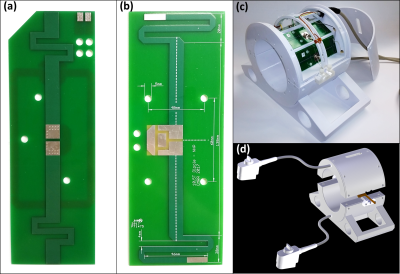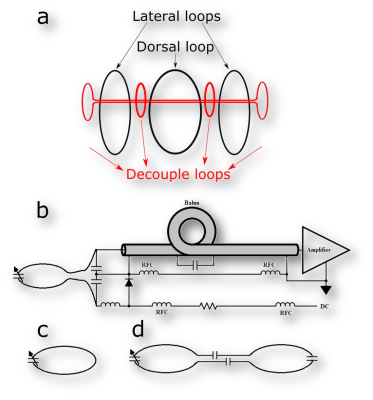RF Coils & Electronics
Traditional Poster
Engineering
Tuesday, 19 June 2018
| Exhibition Hall 1689-1736 |
13:45 - 15:45 |
|
1689.
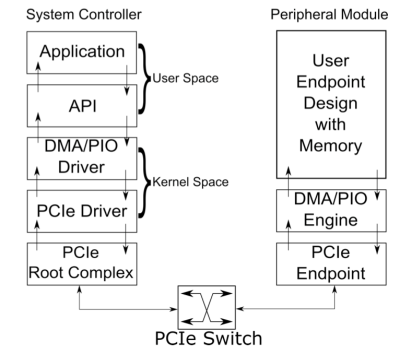 |
Construction of an open PXIe based scalable MRI console
Andrew Ang, Sergei Obruchkov, Robin Dykstra
We have developed an open source PXIe platform tailored for MRI console development. The example design has a multichannel RF transceiver, and signal generation for gradient drive.
|
|
1690.
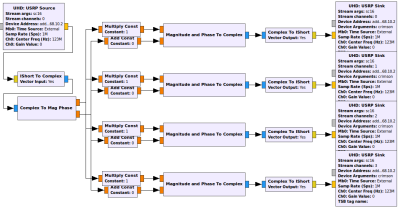 |
Software defined radio-based platform for parallel transmission MRI research
Fred Tam, Benson Yang, Simon Graham
Parallel transmission (PTx) research platforms are challenging to implement and to integrate with commercial MRI systems. A prototype PTx research platform was demonstrated that leverages off-the-shelf software-defined radio (SDR) for flexibility and scalability, with easy integration and moderate cost. The SDR system was evaluated on the bench and connected to a commercial 3-T MRI system for an initial RF shimming demonstration. Substantial latency was found, likely due to the preliminary software implementation, but overall measurements and images were promising. Scaling to 32 transmit channels and applications other than RF shimming are expected to be practical.
|
|
1691.
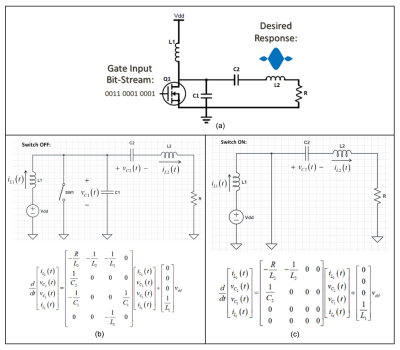 |
A Gate Modulated Digitally Controlled Modified Class-E Amplifier for On-Coil Applications in 1.5 T MRI
Bismillah Nasir Ashfaq, Fatima Tu Zahra, Berk Silemek, Ugur Yilmaz, Ergin Atalar
A novel technique of modulating both the amplitude and frequency of the desired MR Radiofrequency pulse in a class-E amplifier topology, without utilizing supply-modulation, is presented. Amplifier’s MATLAB model is developed and the carrier frequency bitstream is intelligently controlled to achieve both the amplitude and phase modulation of the output waveform. Benchtop experiments are performed showing accurate translation of software predictions on hardware, however requiring some additional optimization steps. MR experiments are performed to demonstrate the slice-selective capability of the generated RF pulse. Images are acquired at input powers of up to 80 W with 89% peak drain efficiency.
|
|
1692.
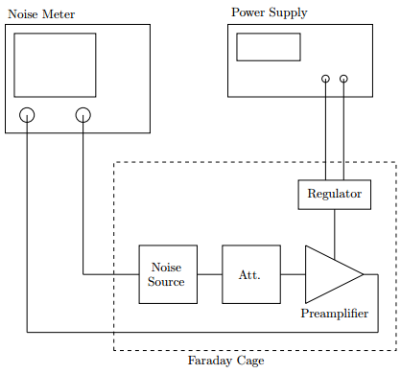 |
Accurate Noise Figure Measurements for Highly Mismatched Preamplifiers
Daniel Højrup Johansen, Juan D. Sanchez-Heredia, Vitaliy Zhurbenko, Jan H. Ardenkjær-Larsen
A method reducing the uncertainty of noise figure measurements of highly mismatched preamplifiers is presented. In many cases when measuring the noise figure of preamplifiers for MRI receive arrays the uncertainty is approximately ±0.4 dB. Since the noise figure of the preamplifier is also in this range, a more accurate method is needed. Here we show an increase of 59 % in noise figure accuracy by adding an attenuator between the noise source and preamplifier.
|
|
1693.
 |
A Tx/Rx Coil Concept Using the Same Receiver Array Coils
Xiaoyu Yang, Haoqin Zhu, Tsinghua Zheng, Yong Wu
Typical Tx/Rx coils require a separate local transmitter and complicated T/R switches to make a local transmitter. They are expensive and may degrade receiver coil performance. We propose a novel Tx/Rx coil concept using the same receiver array coils. All receiver coils are allowed to inductively couple to the WBC in Tx mode. The combined induced amplified Tx field from the array coils is uniform and can be used as local Tx B1 field. This new concept simplifies Tx/Rx coil design and enables highly parallel array coil design with local Tx capability.
|
|
1694.
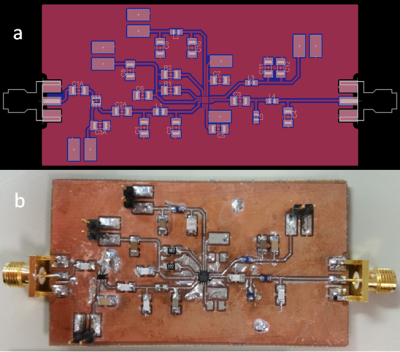 |
A Low Cost Prototype Pre-Gate Amplifier to Study Radiofrequency Power Amplification for Parallel Transmission MRI at 3 T
Benson Yang, Simon Graham
There is a growing interest to increase the channel count on parallel transmit systems. With system cost always a major consideration, substantial savings may be possible as the channel count becomes high (ie. ≥32). Typically, radiofrequency power amplifier (RFPA) designs involve multiple amplification stages to achieve a target output power. Three stages are identified in the design approach of the present work: (1) a low noise pre-amplifier; (2) a driver amplifier; and (3) a power gain amplifier. The present goal is introduce and characterize system architecture for a prototype “pre-gate” amplifier (stage 1 and 2) to explore power amplification technology for stage 3 of the RFPA.
|
|
1695.
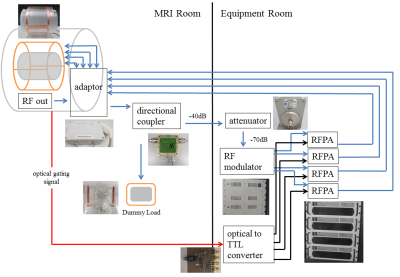 |
A Prototype Four-Channel Parallel Transmission System to Investigate MRI Safety at 3 T
Benson Yang, Fred Tam, Pei-Shan Wei, Clare McElcheran, Simon Graham
Interest in parallel transmission (pTx) continues to grow with many research groups investigating methods to increase channel count and applications on commercial MRI systems. It can be challenging, however, to integrate pTx hardware onto existing systems without disrupting normal operation. The present work successfully interposes a four-channel pTx system on an existing 3 T Siemens Prisma system and performs validation to demonstrate: (1) four-channel radiofrequency (RF) shimming; and (2) reduced RF heating in an electrically conductive implant.
|
|
1696.
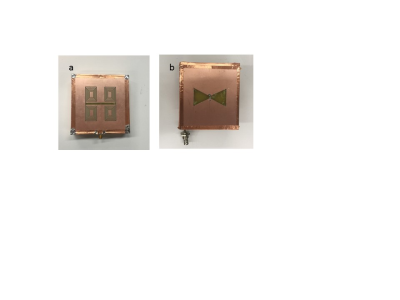 |
A meander slot element with microstrip line match and tune
Dheyaa Alkandari, Chung-Huan Huang, Steven Wright
lot antennas have been widely used in communications because of their obvious low-profile nature. In MRI applications, the ability to ‘hide’ ancillary electronic components behind a shield containing a slot antenna could lead to interesting and very “clean” transmit antenna designs. Using the meander slot as elements for multi-channel coils allows for more compact multi-channel transmit coil designs with a shielded “clean” imaging area. This shielded imaging area provides a desirable environment for placing a receiver coil. More importantly, using meander slot coil elements can potentially allow for the design of multi-channel coils without the need of using matching and tuning networks or decoupling circuits. We believe this may significantly simplify the design of multi-channel transmit coils.
|
|
1697.
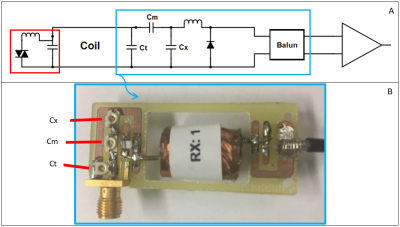 |
A 32-Channel Array Coil for Bilateral Breast Imaging and Spectroscopy at 7T
Romina Del Bosque, Matthew Wilcox, Jiaming Cui, Sergey Cheshkov, Ivan Dimitrov, Craig Malloy, Steve Wright, Mary McDougall
This work describes the design, construction, and performance of a 32-channel array coil for bilateral breast imaging at 7T. Imaging indicated an increase in average SNR over a T/R volume coil of 5.5 times, with a three times increase in the center and up to 20 times along the periphery. Channel noise correlations indicated well decoupled elements and highly unilaterally isolated sets of 16 elements. In combination with high field strength benefits, this array will enable high resolution accelerated breast imaging.
|
|
1698.
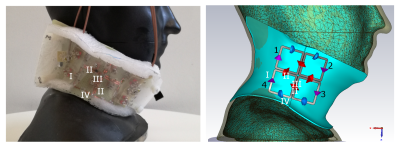 |
A Neck Adapted 4-Ch Saddle-Shaped pTx Transceive Coil for Carotid Imaging at 7T
Fabian Kratzer, Reiner Umathum, Sebastian Flassbeck, Thomas Fiedler, Andreas Bitz, Mark Ladd, Gregor Adriany, Sebastian Schmitter
Stroke is one of the most common causes of death, often caused by accumulation of plaques in the carotid arteries. This motivates investigating the anatomy and blood hemodynamics in the carotid bifurcation with high resolution. For early diagnostics, this work presents a new, saddle-shaped neck-adapted 4-channel parallel transceive coil for imaging at 7T. Coil design and optimization were performed using numerical simulations, and a safety assessment was performed with an anatomical body model. A head-shoulder phantom was built and used to validate measurements. High-resolution anatomical images and flow measurements were acquired in the common carotid artery.
|
|
1699.
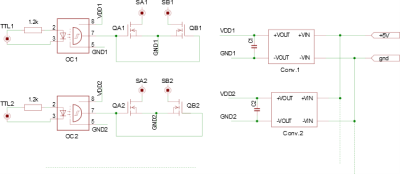 |
A Fast MOSFET RF Switch for TRASE MRI at Low Magnetic Field
Pierre-Jean Nacher, Sashika Kumaragamage, Geneviève Tastevin, Christopher Bidinosti
TRansmit Array Spatial Encoding (TRASE) MRI uses trains of B1 pulses alternatively produced by distinct transmit coils. Commonly used coil switching involving PIN diodes is too slow for low-field MRI and would introduce wait times between pulses typically as long as each individual pulse (hence, significant diffusion-induced resolution loss in TRASE MRI of gas samples). A MOSFET-based RF switch is described and characterised. Up to 200 kHz, it allows for sub-µs switching of RF currents from a single amplifier to several coils with sufficient isolation ratio and no delay between pulses.
|
|
1700.
 |
A 22-Channel RF coil array for fetus MR imaging at 3T
Chao Luo, Guoxi Xie, Jo Lee, Xing Yang, Xiaoliang Zhang, Xin Liu, Ye Li
Due to lack of dedicated fetal imaging RF coils, the system body coil is often used to acquire fetal images. This setup is not optimized and offers limited sensitivity and image quality. In this work, we designed and manufactured a 22-channel flexible coil array for fetal examinations. Compared with Siemens 6-channel body coil, the proposed fetal coil array achieves significant improvements in imaging coverage, image SNR and parallel acceleration capability.
|
|
1701.
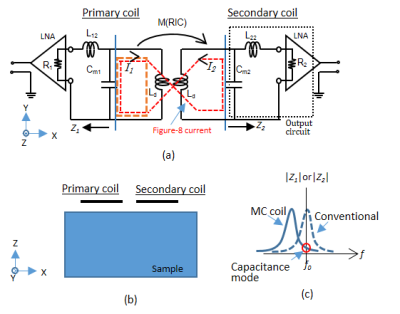 |
Magnetically coupled RF coil for optimizing noise correlation
Yosuke Otake, Kohjiro Iwasawa, Hisaaki Ochi, Masayoshi Dohata, Yoshihisa Soutome
A magnetically coupled radiofrequency (RF) coil (MC coil) for optimizing noise correlation has been developed. The electric fields of each RF coil, which determine noise correlation, were controlled by a small magnetic coupling between a pair of RF coils. The MC coil was implemented as a two-channel loop coil in 1.5 T magnetic resonance imaging (MRI). The experimental results show that noise correlation can be controlled by using a small magnetic coupling without signal-to-noise ratio (SNR) loss. MC coils that can optimize noise correlation give a new degree of freedom to coil design.
|
|
1702.
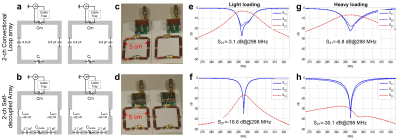 |
Small self-decoupled RF coils
Xinqiang Yan, John Gore, William Grissom
The self-decoupled coil that is intrinsically decoupled proves to be a simple way to solve coupling issues in RF arrays. Small mode capacitances are needed to balance the dipole- and loop-mode coupling in self-decoupled coils, which then requires the addition of inductors to maintain the resonant frequency. But inductors may lead to loss and thus decrease transmit efficiency. In this work, we investigated the performance of small self-decoupled coils at 7T and compared it to ideal conventional coils. It was found that the coil performance of self-decoupled array could be well preserved so long as the sample loss is dominated. Based on these simulation and experimental results, the self-decoupled coil is a good candidate for dense coil arrays at ultrahigh fields.
|
|
1703.
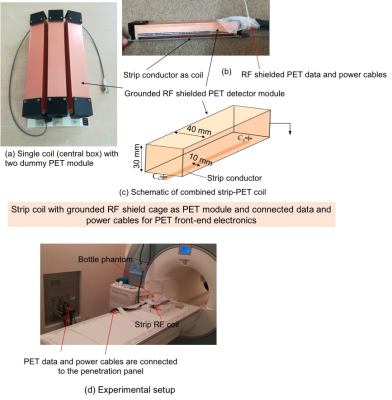 |
Strip transmission line RF coil combined with RF shielded PET detector for existing MRI systems
Md Shahadat Hossain Akram, Takayuki Obata, Taiga Yamaya
PET insert for the existing MRI systems can be a potential affordable alternative of body PET/MRI system. To avoid mutual interference between PET front-end electronics and the MRI system, PET front-end (F/E) electronics are enclosed in RF shielded Faraday cage that is connected to the RF ground for shielding purpose. On the other hand, strip transmission line RF coil requires a grounded plane in parallel with a strip conductor as coil that are connected by shunt capacitors. In this study, we proposed a strip transmission line coil that replaced the ground one layer conductor with the shielded PET detector module. The combined system shows promise for a compact PET/RF coil modality as insert for simultaneous PET/MR imaging with existing MRI systems, suitable even at ultrahigh field MRI.
|
|
1704.
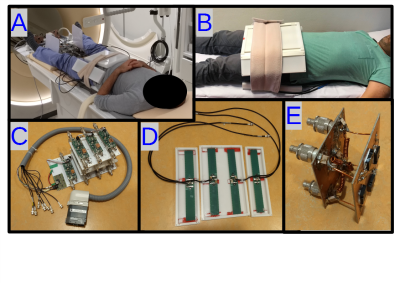 |
Fixed-phase prostate imaging with a 8-channel transmit/receive dipole antenna array on a conventional 3T system
Aidin Haghnejad, Mark Gosselink, Ingmar Voogt, Dennis Klomp, Peter Luijten, Alexander Raaijmakers
Local multi-transmit arrays at 3T provide reduced power requirements and reduced local SAR. However, it requires 3T scanners with multi-transmit functionality which are rare. This work presents add-on hardware that enables the use of local transmit/receive arrays. An exploration on prostate imaging with fixed phase settings using a 8-channel dipole array has been performed on four subjects. B1+ levels range from 5 to 8.5 uT for 8 x 215-300 W input power. T2w images have been acquired successfully for each subject. The modest inter-subject variation in B1+ demonstrates the feasibility of this approach.
|
|
1705.
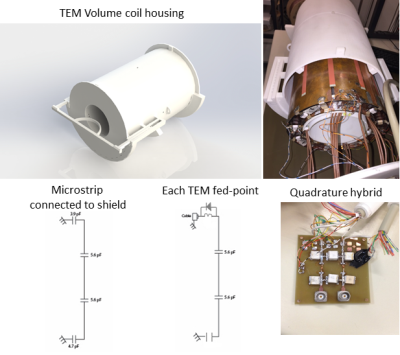 |
Large FOV 16-channel receive array with a volume transmit coil for human forearm/wrist/hand imaging at 7 T
Özlem Ipek, Jérémie Clément, Maria Isabel Vargas
A large-field-of-view 16-channel circular loop receive array with a volume transmit coil for the human forearm, wrist and hand imaging at 7 Tesla was constructed. While the volume transmit coil yields homogeneous transmit field distribution along the 350-mm in length , the 16-channel receiver array enables two times faster imaging with a similar MR image quality. In conclusion, the use of this large field-of-view RF coil configuration for a total MR protocol of 15 minutes is feasible, and it enables visualization of different anatomical structures on the human forearm and hand at 7 Tesla.
|
|
1706.
 |
A Flexible Transceiver Array for Cardiac MRI at 7 T: Performance Evaluation on a Torso Phantom
Sajad Hosseinnezhadian, Roberta Frass-Kriegl, Sigrun Goluch, Michael Pichler, Jürgen Sieg, Marie Poirier-Quinot, Luc Darrasse, Ewald Moser, Jean-Christophe Ginefri, Elmar Laistler
A flexible 12-channel transceiver transmission line resonator (TLR) array for 7 T cardiac 1H MRI compatible with parallel transmission systems was developed. The size of the array is 38 cm x 28.5 cm with individual TLRs of 84 mm diameter. A decoupling ring-based inter-element decoupling technique was used where the basic TLR geometry is surrounded by a conducting ring. Its efficiency was demonstrated with the array bent on a torso phantom and a human torso (Sij < -16 dB). Acceleration factors up to 3 in bent configuration can be employed without significant SNR degradation (g-factor < 1.6).
|
|
1707.
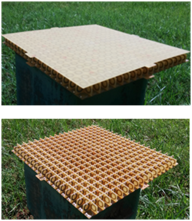 |
Sensitivity Improvement of Quadrature Surface Coil using Isotropic Metamaterial Flat Lens
Tejkiran Patil, A. Sidhique, Pulkit Sharma, Rajesh Harsh, P. Rao
Metamaterial lens has previously been used to improve the sensitivity of phased array coils and the improvement is specifically seen at the epicenters of the loops and a sharper notch is formed at the critical overlapping region because of high resolving capability of the lens and it is not desirable for larger field of view (FOV). This work proposed a novel concept of nearly constant improvement in receiver sensitivity over the FOV using a combination of both metamaterial flat lens and quadrature surface coil.
|
|
1708.
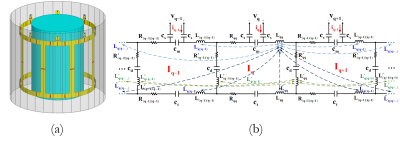 |
A 12-Channel Degenerate Birdcage Body Transmit Array Coil for 1.5T MRI Scanners
Ehsan Kazemivalipour, Alireza Sadeghi Tarakameh, Ugur Yilmaz, Volkan Acikel, Bulent Sen, Ergin Atalar
In this work, we designed and manufacture a 12-channel body birdcage degenerate transmit array coil. After determining the size of the coil, the trace thickness for each of the conductors and the location of the capacitors, an EM solver is used to find the equivalent circuit model of the coil. The capacitor values are tuned by solving the circuit model and recalculating the EM model iteratively. After reaching the minimum total reflection of 14%, we constructed the 12-channel body degenerate birdcage transmit array coil. The strongest coupling was observed between adjacent channels measuring as -15.7 dB.
|
|
1709.
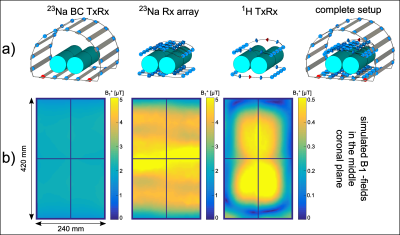 |
A double resonant (1H/23Na) whole-body RF system for MRI at 3T
Matthias Malzacher, Nadia Paschke, Jorge Chacon-Caldera, Lothar Schad
23Na MRI keeps increasingly demonstrating diagnostic value in a multitude of studies and clinical applications due to its capability to provide information on tissue viability. In order to co-register 23Na and 1H MR images, a double resonant 23Na/1H RF system is the optimal solution. In this work we present a clinical double-resonant RF system consisting of a shielded 23Na BC coil, a 16 channel 23Na Rx array and a local 1H Helmholtz coil inside the shielded 23Na BC coil. The complete system is demonstrated in EM simulations and initial feasibility measurements are performed.
|
|
1710.
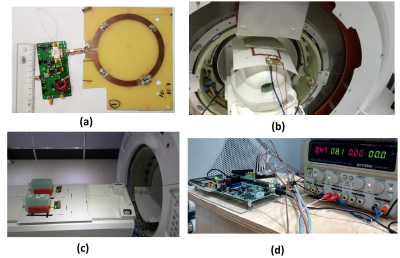 |
300 W Modified Class-E RF Amplifiers for 64 MHz Transmit Array System
Fatima tu Zahra, Bismillah Nasir Ashfaq, Berk Silemek, Ugur Yilmaz,, Redi Poni, Ergin Atalar
In this work, highly efficient 300 W digitally controlled supply-modulated Class-E amplifiers for two-channel RF transmit array are presented. Load pull analysis is performed for load optimization purposes. Coupling between the transmit coils is measured to be 8% when 12 cm diameter coils are placed with a distance of 7 cm. The performance of amplifiers while working simultaneously at same frequency and at different frequencies is evaluated. MR experiments are conducted and it is observed that MR images show no artifact in the presence of amplifier near transmit coil inside the scanner.
|
|
1711.
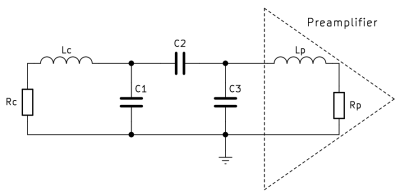 |
Ideal Coil Decoupling in Receive Arrays using Negative Resistance Preamplifiers
Daniel Højrup Johansen, Juan D. Sanchez-Heredia, Vitaliy Zhurbenko, Jan H. Ardenkjær-Larsen
This work presents the method of achieving ideal decoupling between elements in a receive coil array. Generally, preamplifier decoupling is limited by nonidealities of the implemented components. It is shown analytically and numerically, that for the ideal (lossless) matching circuits the input resistance of the preamplifier should be zero, while for the realistic lossy case a small negative resistance can be used to achieve ideal decoupling. Here we use a negative input resistance preamplifier (NIRP) to compensate for the loss of the circuit. The analysis is verified experimentally showing a decoupling of -62 dB when a NIRP with an input resistance of -0.023 ? is used.
|
|
1712.
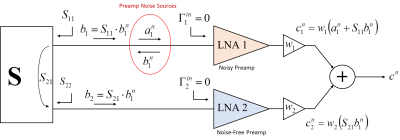 |
Using Noise Waves for Simulation and Measurement of Array SNR Penalty due to Passive Impedance Match
Arne Reykowski, Christian Findeklee, Paul Redder, Tracy Wynn, Tim Ortiz, Randy Duensing, Scott King
Active impedance matching versus passive impedance matching of array coils is a concept well understood when designing transmit arrays. Lesser known however is that this concept also applies to receive arrays. Even though it appears that preamplifiers are noise matched to the passive port impedance (usually 50 Ohms), preamplifier noise coupling creates active noise match impedances which are mode dependent. In this context, a mode is defined by a signal vector and the corresponding weighting factors for optimum combined SNR. We use coupled noise waves to explain by simple concepts how the weighted and combined coupled noise changes the active noise match impedance.
|
|
1713.
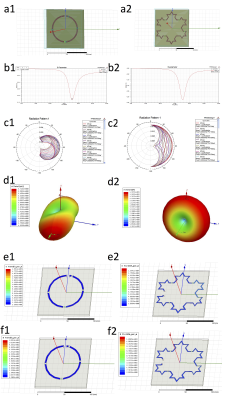 |
Micro-strip Surface Coils Using Fractal Geometry for 129Xe Lung Imaging Applications
Olga Dona Lemus, Norman Konyer, Michael Noseworthy
We compared a fractal patterned micro-strip surface coil with a simple circular micro-strip surface coil for hyperpolarized 129Xe lung imaging applications. Both patterns were simulated using a finite element solver and electric and magnetic fields were calculated in the surface coil and adjacent air volume. The fractal-patterned coil showed relatively higher magnetic field compared to the circular coil in both the micro-strip surface and the air volume. Although, further simulations are required, fractal-patterned designs of MRI coils could offer specific improvement in signal penetration and magnetic field homogeneity.
|
|
1714.
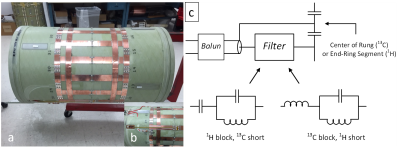 |
A Dual-Tuned 70 cm Whole-Body Resonator for 13C and Proton MRI/MRS at 3T
Ed Boskamp, Zhentian Xie, Victor Taracila, Amy Stephen, Mike Edwards, Tim Skloss, Ralph Hurd, Fraser Robb, Joe Murphy-Boesch
Hyperpolarized 13C enhances the SNR of signals from 13C metabolites. Separate transmit and receive coils are inserted into the magnet bore to image 13C, limiting patient space. Here, a dual tuned 13C /1H body coil is developed that is capable of imaging both proton and 13C in one exam. The coil has the same 70 cm inner diameter as the standard body coil and can be used stand-alone as the Tx/Rx coil, or as the transmit coil for proton and 13C receive arrays. The efficiency for proton excitation is comparable to that of the standard proton only body coil.
|
|
1715.
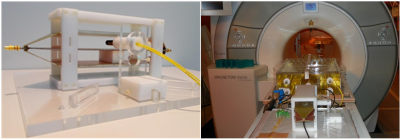 |
High precision MR-TEM cell for in-situ calibration of RF field probes in clinical MR systems
Frank Seifert, Bernd Ittermann
An MR-TEM cell is a transverse electromagnetic (TEM) cell operated as a Tx/Rx coil directly inside an MR scanner. From a precise flip angle measurement in a tiny sphere of water the RF electric field inside the cell can be determined using the TEM condition |E|=2c0|B1+|. Thus, an MR-TEM cell can be utilized for the calibration of RF E- and H-field probes as well as for the determination of the RF voltages and RF currents at its ports which is important e.g. for experimental validation of simulation results in RF safety research. We report here on the high precision flip angle calibration of an MR-TEM cell with 0.1% uncertainty.
|
|
1716.
 |
Dual-resonant helmet coil for 1H/31P at 3T MRI
Suk-Min Hong, Chang-Hoon Choi, Jörg Felder, N. Shah
The partial volume helmet coil is the intermediate coil type between surface coil and volume coil in terms of SNR and B1 uniformity. The helmet coil was introduced to increase the filling factor leading to increasing SNR. In this study, we modified the helmet coil geometry by inserting additional ring to achieve a dual resonance, which is tuned for 1H/31P. The feasibility of dual-tuned helmet coil was evaluated by simulation and MR measurement, and the results were compared with those acquired by commercial single- and dual-tuned birdcage coils.
|
|
1717.
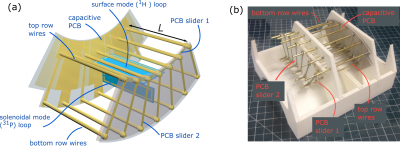 |
A genuine design for a dual-tuned $$$^{1}H/^{31}P$$$ coil with no lumped elements operating at 4.7T
Anna Hurshkainen, Anton Nikulin, Stanislav Glybovski, Christophe Vilmen, Marc Dubois, Djamel Berrahou, Stefan Enoch, Irina Melchakova, Pavel Belov, Redha Abdeddaim, David Bendahan
For a wide range of MRI and MRS applications dual-tuned MR coils are used capable of multi-nuclear studies. Conventional ultra-high-field preclinical dual-tuned coils are either surface loops having high SNR over a limited FOV or volumetric coils with ultimate coverage compromised by low SNR while used in Tx and Rx regimes. In this contribution we propose an alternative design of the dual-tuned 1H/31P coil based on an open self-resonant periodic structure, which doesn’t require variable lumped capacitors for tuning and matching. It has been shown that the proposed coil is suitable for studying energetics in human forearm muscles at 4.7T.
|
|
1718.
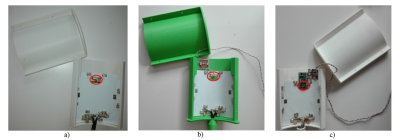 |
Decoupling strategies for Double Tuned Radio Frequency coils at 7T
F. Maggiorelli, E. Boskamp, A. Retico, G. Tiberi, J. Kaggie, F. Robb, M. Tosetti
Magnetic Resonance Imaging (MRI) and Spectroscopy (MRS) with nuclei different from protons, often require the acquisition of proton signal for shimming and co-registration procedures. For this purpose Double Tuned Radio Frequency (DT-RF) coils are needed. The drawback of DT-RF coils is basically the coupling between the two resonant structures, which reduces SNR and increases focal heating. The aim of this study is to compare active and passive decoupling strategies in terms of Q factor and S21 parameter. Workbench measurements show that PIN Diode active decoupling is an interesting alternative for DT-RF coils.
|
|
1719.
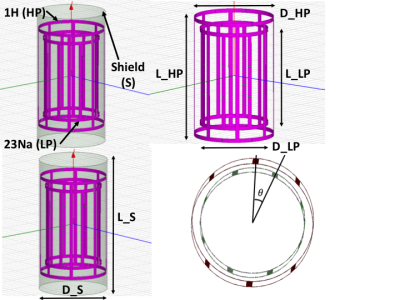 |
Optimization study of a double-tuned nested birdcage RF coil for 1H/23Na MRI
Angelo Galante, Marco Fantasia, Marcello Alecci
The nested birdcage design is useful to develop dual tuned volume transceiver RF coils. Despite its apparently simple design, coupling among coils affects the resonance frequencies, making its practical realization cumbersome. FEM simulations were first validated by workbench measurements for a specific nested double-birdcage suitable for 1H/23Na MRI at 2.35T. Then were used to study the isolation and RF efficiency for a set of different geometrical parameters. We demonstrate that an optimized nested design is obtained if the disposition of the birdcages rugs, lengths and shield diameter are carefully taken into account.
|
|
1720.
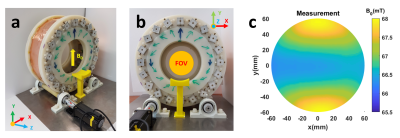 |
The Design of A Short Solenoid with Homogeneous B1 for A Low-field Portable MRI Scanner Using Genetic Algorithm
Zhi Hua Ren, Shao Ying Huang
A short solenoid that provides field homogeneity with relatively low inductance and low length-to-radius ratio was successfully designed and validated to work in a Halbach array based portable MRI scanner. The optimization is done by applying genetic algorithm and by using Bio-Savart Law as a forward calculation model. The optimized design shows advantages of much higher homogeneity with a practically small length-to-radius ratio compared with a constant-pitch solenoid.
|
|
1721.
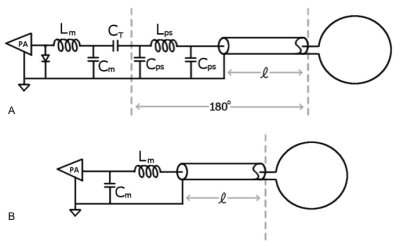 |
Remote tuning and matching of a non-resonant wire loop
J. Rock Hadley, Laura Slusser, Robb Merrill, Dennis Parker
There are several situations, such as some interventional applications or intracavitary placement, where it would be desirable to remotely tune and match a local RF coil. Although remote lumped element placement will result in decreased SNR, it is likely that net loss in SNR may be a function of the designs used. This study investigated the SNR trade-off of different methods of remote tuning by comparing the SNR that could be achieved with the placement of lumped elements at the coil. A large variation in SNR based on method was observed.
|
|
1722.
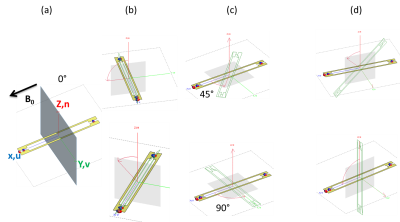 |
Endoluminal coil-sensitivity degradation with the coil-orientation effect with respect to B0 field: preliminary results
HAMZA RAKI, SIMON A. LAMBERT, KEVIN TSE VE KOON, HENRI SOUCHAY, FRASER ROBB, ISABELLE SANIOUR, OLIVIER BEUF
Single-loop endoluminal RF-coils are a possible solution for the SNR limitations of external coils. However, they suffer from signal variations due to the coil sensitivity dependence with the coil orientations with respect to the B0 field. We simulated (electromagnetic simulations with Feko) an RF-coil along the Ox axis (0°) taken to be that of the B0 field and for specific coil orientations (30, 45, 60 and 90°) around and in oblique position with respect to the Ox axis (B0). We then evaluated the signal distribution (H-field 2D map) variation with the coil orientations to can propose an adequate architecture.
|
|
1723.
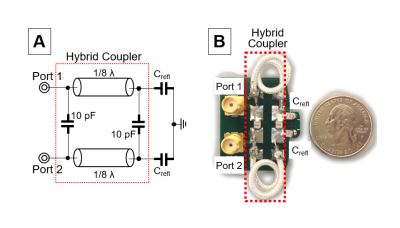 |
Tunable Phase Shifters and Ratio-adjustable Power Splitters for Array-compressed Parallel Transmission and MR Fingerprinting
Charlotte Sappo, Xinqiang Yan, William Grissom
Array-compressed parallel transmission was recently proposed as a way to reduce the number of RF power amplifiers required for many-coil parallel transmission [1]. This is achieved by connecting a large number of coils to a small number of amplifiers via an array compression network that implements optimized coil-to-channel combinations using ratio-adjustable power splitter (RAPS) circuits [2,3] and phase shifters. Currently, the RAPS circuit ratios are determined by tuning coaxial cable lengths within the RAPS circuit (Figure 2), but this prevents dynamic switching of the compression weights via remote tuning. Remotely tunable RAPS circuits and phase shifters would also be useful for dynamic mode switching in MR fingerprinting [4,5]. To achieve this, here we describe the design and validation of a quad hybrid-based phase shifter that can be tuned by varying terminating capacitors, and integrate it into a RAPS circuit. Bench tests and 7T imaging and B1+ mapping experiments were performed to validate the phase shifters and new RAPS circuit design.
|
|
1724.
 |
A low cost Internet of Things solution for real time magnetic field measurement for MRI polarization coils using a computer numeric control machine
Priyanka Harish, Likith P S, Mamatha M R, Meghana S, Vikas Vasisht A, Sairam Geethanath
An Internet of Things solution for real time Magnetic Field Measurement of polarization coils using Computer Numeric Control (CNC) machine was developed in order to automatically map the static magnetic field at a low cost ($722). The results were transformed into a visualization report of the magnetic field and uploaded on the cloud server. This report can be accessed by any authorized user with an internet connection from any device, to conduct further analysis. The magnetic field measuring CNC is a multipurpose 3-axis robotic system which can be equipped with other field probes to serve as a multi-parametric measurement device.
|
|
1725.
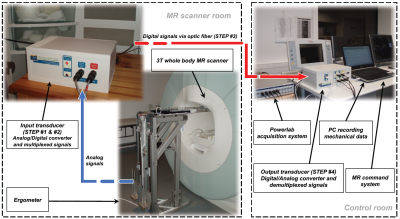 |
Optoelectronical-based multiplexed transmission of analog signals in a magnetic environment.
Christophe Vilmen, Louis Bortoli, Evan Gallouin, Maxime Guye, Monique Bernard, David Bendahan, Alexandre Fouré
This study describes the methodological developments to both convert and transmit several mechanical signals in a magnetic environment (3T Verio Siemens) as optical signals. Multiple sensors were connected to a MR-compatible ergometer used to assess dynamic knee extensions kinetics. The corresponding signals were analog to digital converted and transmitted as optical signals through a single optical fiber. The quality of mechanical and 31P MR spectroscopy (31P-MRS) signals remained high and disclosed no adverse interference from the transducers ensuring both conversion and transmission. The multiplexed signals transmission allowed an accurate assessment of human movement kinetics in a magnetic environment.
|
|
1726.
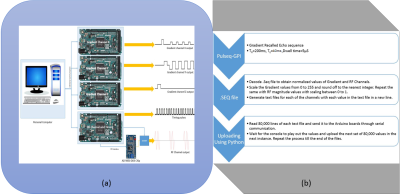 |
Pulseq-GPI Compatible console for 9.5mT MRI system
Syed Siddiq, Sneha Potdar, Sairam Geethanath
A cost effective console, compatible with Pulseq-GPI has been designed for 9.5mT using general purpose microcontroller boards. Data from Pulseq-GPI was extracted in a text file and uploaded on the microcontroller to play the gradient waveforms (Gx, Gy) and radio frequency (RF) pulses, with a dwell time of 5us. Current work involves integration of Analog to Digital Convertor (ADC) for Gradient Recalled Echo (GRE) sequence and reducing the time required to upload the waveforms for the entire sequence. Future work involves interfacing the console with coil driver apparatus to integrate with 9.5mT lab MRI systems.
|
|
1727.
 |
10µm isotropic voxels acquired with a CMOS-based planar microcoil at 14.1T: Preliminary results
Marlon Pérez Rodas, Jonas Handwerker, Hellmut Merkle, Rolf Pohmann, Jens Anders, Klaus Scheffler
The quest for high resolution MR have push the technology to miniaturization. Thus, microcoils have been used for imaging with very high resolution. Here, we have designed and constructed a fully integrated CMOS NMR transceiver containing an on-chip microcoil, integrated amplifiers and demodulator for the high-frequency MR signal. In the present work, the initial microimaging results of this fully-integrated NMR transceiver in a 14.1 T animal scanner are presented. The on-chip microcoil allows imaging with a spatial resolution down to 10 µm with an SNR of 64 and with an improvement in SNR/volume ratio of 150 compared to a 10 mm surface coil.
|
|
1728.
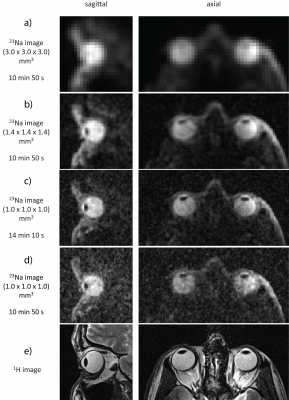 |
High Definition Sodium (23Na) In Vivo MRI of the Human Eye at 7.0 Tesla: Need for Substantially Enhanced Spatial Resolution than Commonly Used in Brain MRI
Daniel Wenz, Andre Kuehne, Till Huelnhagen, Armin Nagel, Helmar Waiczies, Oliver Stachs, Erdmann Seeliger, Bert Flemming, Thoralf Niendorf
Sodium ions are crucial in the physiology of human eye and its compartments like vitreous humor, aqueous humor, lens and retina. In this work we used a six-channel transceiver array dedicated for ocular 23Na MRI and obtained in vivo images of the eye of exceptional quality with enhanced spatial resolution like (1.0x1.0x1.0) mm3 and demonstrated why spatial resolutions currently used for sodium MRI of the human brain are not sufficient in the context of 23Na in vivo MRI of the human eye. Enhancing spatial resolution is essential to investigate changes of sodium concentration in subtle eye compartments (aqueous humor, lens).
|
|
1729.
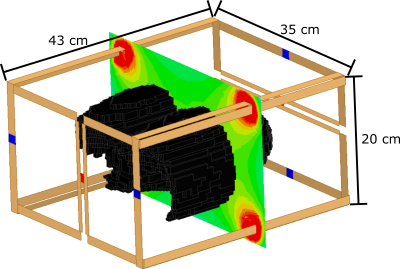 |
A 3D printed lung phantom for exploration of the limits of 19F-C3F8 ventilation imaging resolution and SNR
Adam Maunder, Fraser Robb, Madhwesha Rao, Jim Wild
Fluorinated gas imaging is a complementary method to hyperpolarized gas ventilation imaging, but suffers from lower SNR by virtue of low spin density and thermal polarisation. We present a 3D printed lung phantom based on a gold standard lung ventilation scan acquired from 3He MRI used to explore the limits of fluorinated gas MR in terms of spatial resolution and SNR. Images acquired with unrealistically long imaging times for in-vivo exams were compared to lower resolution images. The results demonstrate that resolutions obtainable with in-vivo fluorinated gas imaging miss potentially important spatial variation information.
|
|
1730.
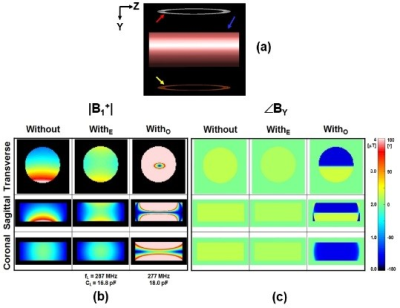 |
Clinical Improvement of 19F Image Sensitivity using the Inductive Coupling at 7.0T Animal MRI
Bu Park, Sunder Rajan, Brenton McCright
We present numerical simulations and experimental validation data testing the feasibility to improve 19F image sensitivity of perfluorocarbon labeled cells using the secondary resonator tuned at 287 MHz to make an enhancing induced RF magnetic field (B1) at 7.0T 19F/1H MRI. The numerical simulation results of |B1+| and corresponding experimental 19F images without and with the secondary resonator tuned at 287 MHz show the improvement of |B1+| and 19F image uniformity. To model a potential clinical application, we used inductive coupling MR to image 19F perfluorocarbon labeled cells encapsulated in polyethylene glycol (PEG) after their transplantation into mice.
|
|
1731.
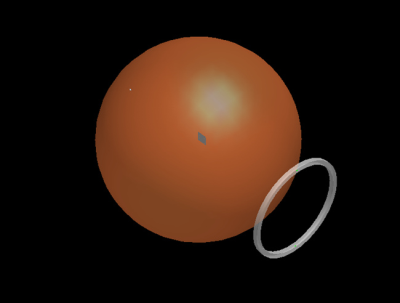 |
A Tool For Rapid Power Analysis for Arbitrary Circular Surface Coil Near Arbitrary Spherical Sample at Any Frequency
Giuseppe Carluccio, Karthik Lakshmanan, Christopher Collins
We present a tool to quickly estimate the noise induced by the resistance of a surface coil and the noise induced by the coil in a sphere. The tool relies on two analytical solutions, and results depend on many parameters. We show plots of the dissipated power in the sample and the coil as function of some of these parameters such as the diameter of the coil, the distance of the coil from the sphere and the wire diameter of the coil. The tool can be useful in the design process of coils, especially dense receive arrays.
|
|
1732.
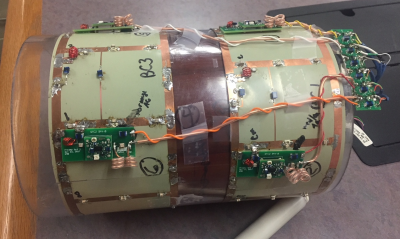 |
Nested Birdcage Receive Array for Simultaneous Multislice EPI
Kenneth Bradshaw, Daniel Sheltraw, Greyson Tarbox, Ben Inglis
We present a novel RF coil design that is capable of simultaneous multi-slice (SMS) echo planar imaging (EPI) for functional MRI along the z axis at 3 T, while maintaining high in-plane (x-y) homogeneity to minimize the effects of receive field contrast on subject motion and motion correction. The coil is symmetric and is open front and rear, making it compatible with fMRI stimulus devices including transcranial magnetic stimulation (TMS) coils.
|
|
1733.
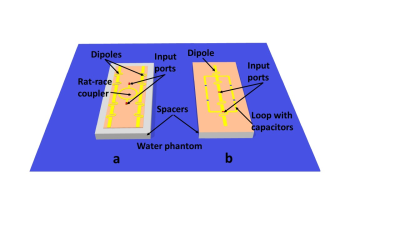 |
A new dual-mode RF-coil array element for 7T MRI based on dipole antennas
Georgiy Solomakha, Stanislav Glybovski, Alexander Raaijmakers, Constantin Simovski , Alexander Popugaev, Irina Melchakova, Pavel Belov, Redha Abdeddaim
In this work, we demonstrate a new RF-coil for 7 Tesla ultrahigh ?eld MRI with two orthogonal channels to achieve better SAR and SNR of images. The ?rst phase of the work involves numerical study of di?erent multimode structures consisting of coupled electrical dipoles to form a radiofrequency coil that may operate both as a surface loop [1] or a single radiative electrical dipole [2] depending on the driven channel.
|
|
1734.
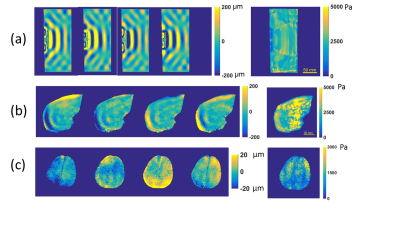 |
Design of an electromagnetic actuator for magnetic resonance elastography
Yuan Feng, Xuefeng Zhao, Suhao Qiu, Mo Zhu, Ping Shen, Shengyuan Ma, Chun-hong Hu, Liang Guo
We introduced a novel design of electromagnetic actuator for magnetic resonance elastography. The actuator consists of a vibration control module and an actuation module. The actuation frequency and magnitude were manually tuned in a control panel of the control module. The actuation module could be easily converted to imaging phantom, organs of the abdomen region and the brain. Results showed a steady elastic wave propagation at gel phantom, liver, and brain tissues.
|
|
1735.
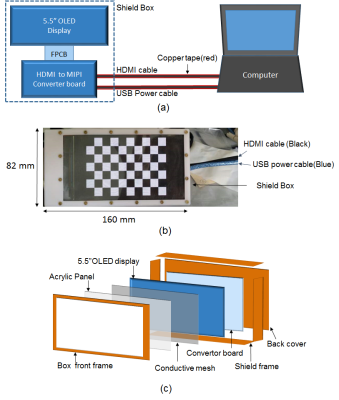 |
MR-Compatible, Organic Light-Emitting Diode (OLED) display for functional MRI
YunKyoung Ko, Seond Dae Yun, Jörg Felder, Chang-Hoon Choi, N.Jon Shah
Functional MRI (fMRI) frequently relies on visual stimulation. In this study, we designed and implemented a MR compatible display unit based on organic light-emitting diodes (OLED) and evaluated its performance on a 3T clinical MRI scanner by carrying out a visual block-paradigm fMRI experiment using the OLED display. The OLED display was successfully operated during the MR measurements. And an fMRI examination was successfully demonstrated with a visual functional study using the OLED display.
|
|
1736.
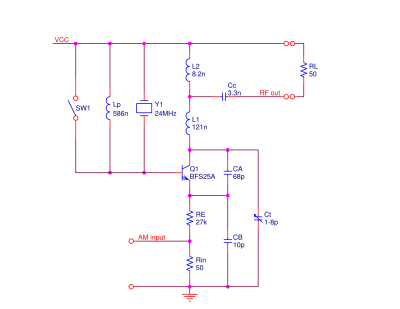 |
Ultra-low power transmitter for encoding non-MR signals in Magnetic Resonance (MR) recordings
Jan Petersen, Jan Ole Pedersen, Vitaliy Zhurbenko, Jan Ardenkjær-Larsen, Lars Hanson
Advancing Magnetic Resonance Imaging (MRI) technology requires integration of the MRI scanners with sensors and systems for monitoring various non-MRI signals. In this paper, we present design and integration of a low power AM radio transmitter into a 3T MRI scanner, which can be used for efficient collection of data from non-MRI sensors. The transmitter consumes only 1.3mW while transmitting 2.7µW at 120MHz with high frequency stability. The presented design is useful in low power applications requiring high frequency stability and is intended for wireless transmission of non-MR signal recordings during MRI scanning.
|
|
PET & Hybrid Systems
Traditional Poster
Engineering
Tuesday, 19 June 2018
| Exhibition Hall 1737-1743 |
13:45 - 15:45 |
|
1737.
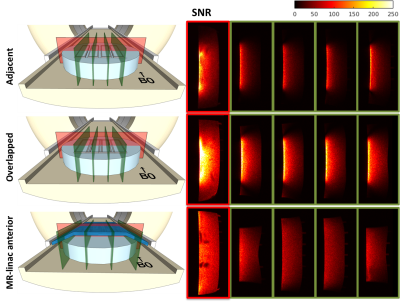 |
Development of a radiolucent 64-channel on-body receive array to enhance image quality of the MR-linac
Stefan Zijlema, Luca van Dijk, Sara Hackett, Jan Lagendijk, Rob Tijssen, Cornelis van den Berg
To improve the spatiotemporal resolution of 3D imaging on the MR-linac, we are developing a new radiolucent 64-channel receive array, which can be placed directly onto the patient during treatments. Coil prototypes caused no significant dosimetric changes. Measurements with 4-channel prototypes showed that overlapping coil loops lead to the highest potential imaging performance. Imaging comparisons with the current MR-linac array showed that the signal-to-noise ratio is improved.
|
|
1738.
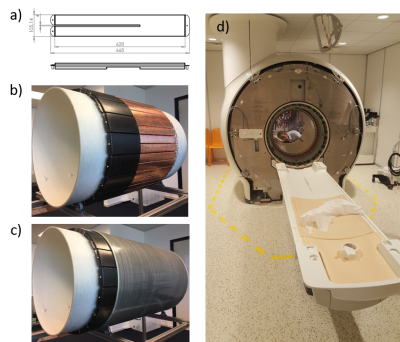 |
Concentric PET shields and wide-bore 1.5 T MR birdcage for optimal MR and PET signal
Deb Rivera, Erik Huijing, Cezar Alborahal, Flavio Meliado, Bart Steensma, Thomas Dey, Volkmar Schulz, Björn Weißler, E Versteeg, Hugo de Jong, Martino Borgo, Michel Italiaander, Dennis Klomp
Prioritizing signal fidelity for PET and MR, we simulated, built, and tested a wide-bore 1.5T body coil with a concentric ring of novel PET shields. With such an approach, the inherent reduced transmit efficiency can be compensated for by applying more power. Through B1+ measurements in phantoms and in the head, we validate that dual RF power amplifiers meet the power requirements.
|
|
1739.
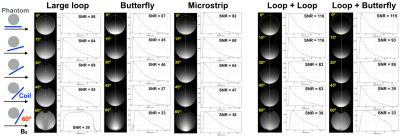 |
Design and evaluation of RF coils for hybrid MR-PET imaging of the prostate
Chang-Hoon Choi, Karl Ziemons, Tim Felder, Hans-Peter Wegener, N. Jon Shah
Prostate cancer is one of the most common diseases in men, and using multimodality, hybrid systems, such as MR-PET provides valuable data for early diagnosis. A human prostate is quite flexible and can move into different positions under external conditions so it is important to localise the critical region-of-interest using both MRI and PET under the same circumstances. In this study, we focused on various MRI RF coil designs suitable for use in MR-PET prostate imaging, and investigated their performance by evaluating SNRs and penetration depths as a function of coil tilting angle against B0.
|
|
1740.
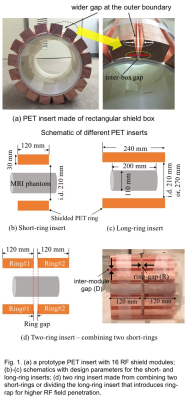 |
A comprehensive study on electrically floating PET insert for efficient RF penetrability at 3 T MRI system
Md Shahadat Hossain Akram, Craig S. Levin, Takayuki Obata, Genki Hirumi, Taiga Yamaya
A comprehensive experimental study has been conducted on the geometrical aspects of electrically floating radio frequency (RF) penetrable PET inserts to improve the RF penetration efficiency for acceptable MR imaging performance. Several one ring and two ring PET insert prototypes were used to do experiments in a 700-mm bore diameter 3 T clinical MRI system with a homogeneous cylindrical phantom. Study results provide guidance for optimized PET ring design for efficient RF field penetration inside the shielded ring.
|
|
1741.
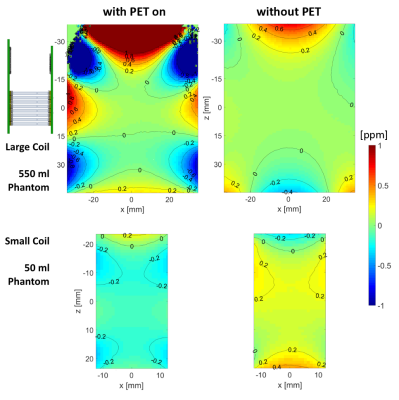 |
MR Compatibility of MADPET4: A Small Animal PET Insert for a 7T MRI System
Geoffrey Topping, Negar Omidvari, Jorge Cabello, Stephan Paul, Markus Schwaiger, Sibylle Ziegler
The impacts of operating a small animal PET insert in a 7T MRI system were studied. The MRI's performance was compared with and without the insert by measuring the static field, flip angle distribution, RF noise, and several imaging sequences with two RF volume coils. With the insert inside a large 1H volume coil, the MR was limited to T1-weighted anatomical imaging, and required a surface receive coil for adequate SNR. With the insert enclosing a small 1H/13C volume coil, the primary impact on MRI was up to 38% reduced SNR, and all tested MRI sequences were functional.
|
|
1742.
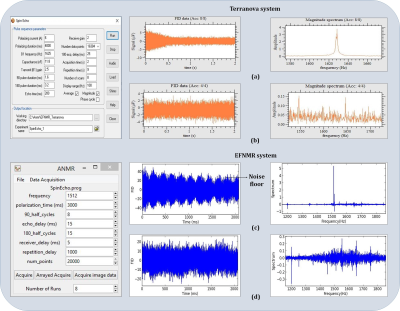 |
Low cost Earth Field NMR Spectrometer with improved Shimming (LESS)
Chennagiri Padma, ThejasVishnu Ramesh, Syed Siddiq, Darshan Keelara, Sairam Geethanath
A simple, portable and low cost Earth’s Field NMR (EFNMR) spectrometer with improved shimming has been demonstrated. Basic NMR principles such as signal transmission, signal detection, and the pulse sequence for MR signal formation have also been demonstrated. The EFNMR spectrometer has been benchmarked with the commercially available Terranova system. The spectrometer was designed with inexpensive and readily available electronic components, costing less than $130. The current work focuses on improving the signal-to-noise ratio of the system using conventional shimming methods, which is a challenge in ultra-low field systems. Future work involves incorporation of gradients and time-shared pulse sequence design.
|
|
1743.
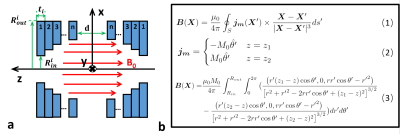 |
A New Yokeless Permanent Magnet Array with High Field Strength and High Field Homogeneity for Low-field Portable MRI System
Zhi Hua Ren, Wen Chuan Mu, Shao Ying Huang
Permanent magnet array is a good candidate for providing the main magnetic field for a low-field portable MRI system. In this abstract, we present the design of a new yokeless permanent magnet array that generates a longitudinal magnetic field with a significant increase in field strength and in homogeneity compared to a traditional two-ring structure. It is compatible with existing RF coils thus the advancement in coil designs can be applied. The optimization was done based on genetic algorithm and a current model which shows much higher calculation efficiency than finite element method. The effectiveness of the optimization is validated by realistic simulations using COMSOL.
|
|
Gradients & Other Effects on B0
Traditional Poster
Engineering
Tuesday, 19 June 2018
| Exhibition Hall 1750-1764 |
13:45 - 15:45 |
|
1750.
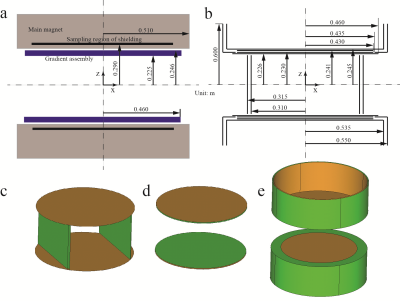 |
An actively-shielded planar gradient coil design scheme in limited coil-layer-placing space
Yaohui Wang, Xuegang Xin, Lei Guo, Zhifeng Chen, Feng Liu
A novel gradient coil design scheme was proposed for use in planar MRI systems. Unlike conventional scheme in a limited magnet pole-pole space which usually applies unshielded design, the novel strategy integrated a set of actively-shielded gradient coils in only four layers in the pole-pole space with the utilization of the system peripheral sections. The design largely improved the shielding effect of the gradient coils and meanwhile left adequate space for the patients and installation of cooling device. The design scheme did not significantly increase the system manufacturing complexity either.
|
|
1751.
 |
High-performance of Multi-axes DWI sequences using Advanced Charge of Gradient power supply
Sho Kawajiri, Yuki Takai, Motohiro Miura, Masashi Hori
Optimizing the energy distribution to the 3 axes output sections of the gradient power supply allows attaining high-performance Multi-axes DWI sequences. In this study, we propose an ‘Advanced Charge’ method for preferential energy supply with one axis emitting the largest fraction of output energy of all 3 axes. To realize it, the energy consumption simulation model for gradient power supply and gradient coil was updated accounting for the energy distribution to each individual axis. The new simulation model was implemented in the Advanced Charge control and the feasibility of high-performance of Multi-axes DWI sequences was then confirmed.
|
|
1752.
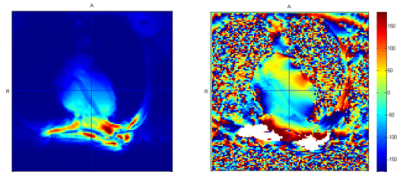 |
Calibration of Siemens MAGNETOM(TM) Terra 7T Shim System and Analysis of Static 3rd-order B0-Shimming of the Heart Using B0DETOX
Michael Hock, Maxim Terekhov, David Lohr, Maria Stefanescu, Anja Schröder, Heike Walles, Christoph Juchem, Laura Schreiber
Susceptibility-induced field inhomogeneities in both space and time make B0-shimming a prerequisite for cardiac MRI at ultra-high field. All individual terms of the static 3rd-order spherical harmonics shim system were calibrated. Field mapping and calculation of shim currents are performed in customized B0DETOX software. Analysis of B0-inhomogeneities is later tested both in measurement of an ex-vivo pig heart and in-vivo in humans. The adjustment of the shim volume to the three measured slices in a healthy volunteer reduced the standard deviation of the field map by 4%, 19% and 18% compared to shimming of the global heart.
|
|
1753.
 |
Interferences of local B0-shim coils and RF coils on a 3T MRI scanner
Qiaoyan Chen, Jo Lee, Jianghong Wen, Chao Zou, Xiaoliang Zhang, Xin Liu, Ye Li
In this work, we quantitatively studied the impact of the local shim coil to RF coil in a combined B0 shim coil and RF coil system in terms of SNR, transmit B1+ and receive B1. By using the results as a design guideline, a 5-channel shim coil was constructed, of which interferences on RF coils were minimized with the appropriate shim coil diameters, number of turns and distances between the shim coil and the sample.
|
|
1754.
 |
Comparison of patient bore tube supporting structures for a high-performance gradient whole-body MRI system to reduce acoustic noise
Hiromitsu Takamori, Kaoru Ikeda, Shoji Ishizaki, Kazuya Okamoto, Hitoshi Kanazawa, Kazuto Nakabayashi
A whole-body MRI scanner with high-performance gradient system produces loud acoustic noise during scan. In the present study we have evaluated the acoustic noise performance for a new gantry structure aimed at noise reduction with a vacuum chamber insert between the gradient coil cylinder and the patient bore tube cylinder. Two different supporting structures for the bore tube were compared. The method supporting the bore tube by means of a beam structure mounted on the feet of magnet scored better performance than the alternative method supporting it by short brackets mounted at the edges of magnet bore opening.
|
|
1755.
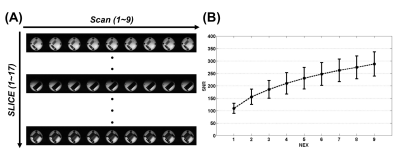 |
A feasibility study of ultra-high-strength gradient system on 3T: demonstration using DTI on anisotropic diffusion fibre phantoms
Ming-Jye Chen, Kuan-Hung Cho, Chang-Hoon Choi, Ezequiel Farrher, Richard Buschbeck, Hsuan-Han Chiang, N. Shah, Hsu Chang, Li-Wei Kuo
In this study, we aimed to integrate an ultra-high-strength gradient system (15 gauss/cm) on a 3T scanner and to demonstrate its feasibility by employing diffusion tensor imaging (DTI) on dedicated anisotropic diffusion fibre phantoms. Two DTI experiments were performed to explore the feasibility of this gradient system, i.e. comparisons of gradient strengths and number of averages. Our results demonstrate reasonable SNR and diffusion contrast acquired on this system using pulsed gradient spin echo diffusion weighted scans could provide useful information. Consistently, it also suggests higher gradient strength could be beneficial to improve the quality of diffusion MRI experiments and its ability to resolve fibre orientations, especially when higher b-values are used.
|
|
1756.
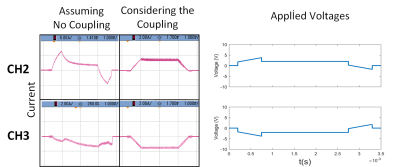 |
Driving Mutually Coupled Coils in Gradient Array Systems in Magnetic Resonance Imaging
Koray Ertan, Soheil Taraghinia, Ergin Atalar
Gradient array systems recently have gained attention due to their various flexibilities and capabilities in different applications. Reducing the mutual-coupling between the coil elements is one of the constraints during the process of the coil design. However, by determining any existing coupling value between the array elements, required decoupling can be achieved. For a typical trapezoidal gradient current waveform, desired voltage values during rise/fall times, are recalculated considering all mutual-couplings between the array elements. This method is evaluated experimentally for different trapezoidal current combinations and can be used in any gradient array system with mutually coupled elements.
|
|
1757.
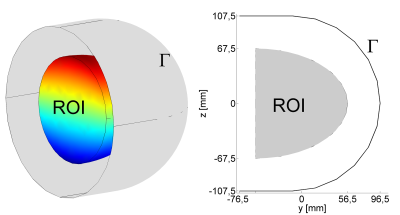 |
Design of breast gradient coil with the control of field nonlinearity
Feng Jia, Sebastian Littin, stefan kroboth, Huijun Yu, Theresa Palm, Frederik Laun, Mark Ladd, Maxim Zaitsev
High performance gradient coils are required to assess the tissue microstructure in human breast in vivo with diffusion-weighted imaging. A deisgn methodology of nonlinear breast gradient coil is proposed to increase resultant gradient strength with the control of field nonlinearity. The method is tested by designing a unilateral breast gradient coil for diffusion weighting. The results are analysis to reveal new insights of coil designs.
|
|
1758.
 |
A Bo Tapestry: MRI Magnet Technology, 1977-2017
Gregory Hurst, Ewald Moser, Martyn Paley, Franz Schmitt
This is a preliminary report from a project to gather and organize an objective historical record of human MRI scanner technology. This report spans magnet technology from 1977 to present (2017), covering about 100 magnets and scanners, and invites additional information.
|
|
1759.
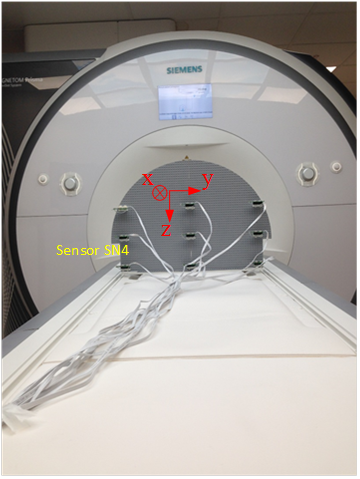 |
Magnetic gradient mapping of a 3T MRI scanner using a modular array of novel three-axis Hall sensors
Joris Pascal, Nicolas Weber, Jacques Felblinger, Julien Oster
This paper presents a multi-point and modular magnetic field sensor system compatible with a 3T-MRI environment. The system features a three-axis magnetometer on a chip. This monolithic sensor is to our knowledge the only integrated sensor commercially available that provides full field vector information as well as sufficient dynamic range and acquisition rate for MRI-applications. We have validated experimentally our demonstrator through the measurement of static magnetic field and magnetic field gradients simultaneously acquired at nine locations within a MRI bore (Prisma, Siemens, Erlangen, Germany).
|
|
1760.
 |
Switched Gradient Impulse Response Measurement with Uniform Excitation of Eigenmodes
Magdoom Kulam, Malisa Sarntinoranont, William Brey, Mareci Thomas
For pulsed field gradient experiments, it is important to characterize gradient switching to correct for errors in measured diffusivity and velocity resulting from imbalances in the gradient time integrals. Accurate characterization of the system requires the time derivative of the test gradient pulse mimic that of an impulse function which excite all the gradient eigenmodes uniformly. We introduce a new test pulse, called the Fresnel pulse whose derivative is a chirp function, which has a uniform spectrum like the impulse function. We also introduce a MR imaging based method to measure the spatiotemporal magnetic fields generated after the test pulse.
|
|
1761.
 |
Analysis of the target gradient method for asymmetric gradient coils
Ashwini Kumnoor, Sebastian Littin, Feng Jia, Sairam Geethanath, Maxim Zaitsev
Gradient coils are traditionally designed using variations of the target field method. For asymmetric coils it may however be advantages to allow for a flexible field offset and specify the field gradient as a target instead. In this work we evaluate the performance of the target gradient method for generating head gradient inserts with a window in a lower face region.
|
|
1762.
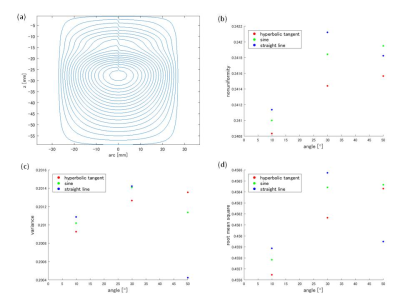 |
Optimization of a traversable wire path of a gradient coil for a magnetic resonance microscope
Takahiro Nishigaki, Shin-ichi Urayama, Naozo Sugimoto, Tomohiro Ueno
We designed 1 T/m gradient coils for a 14.1 T magnetic resonance microscope. The calculated contour wire pattern, however, should be transformed to a traversable wire path for actual construction. In this study, we optimized a connecting method by comparing three loop connecting patterns with the inside and outside return paths as a function of the transition size. We found that larger transition size in smooth parts of the loop reduced more the root mean square of deviations from the center gradient value. This optimization is applicable to gradient coils of larger size.
|
|
1763.
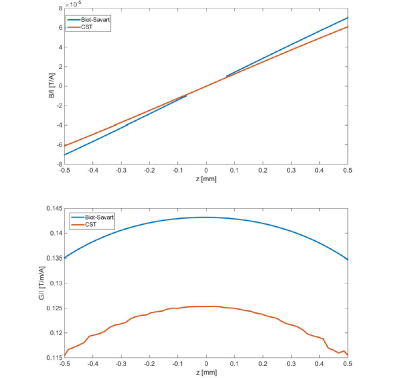 |
Biplanar PCB based Micro-Gradient-System-Insert for a Small Animal MRI
Thomas Hüfken
MR microscopy demands dedicated gradient systems for providing sufficient spatial resolution, which can normally not be met on conventional small animal or whole-body systems. In this contribution a dedicated gradient insert based on a rather simple biplanar design realized with PCB technique is presented. The gradient shows excellent linearity and provides 1.2 T/m amplitude in continuous mode.
|
|
1764.
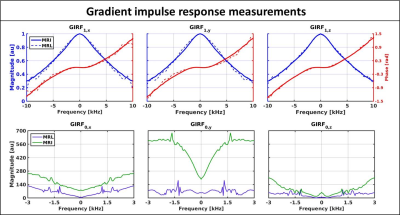 |
Gradient system characterization of a 1.5T MRI-Linac with application to UTE imaging
Tom Bruijnen, Bjorn Stemkens, Jan Lagendijk, Cornelis van den Berg, Rob Tijssen
We characterize the gradient system of a hybrid 1.5T MRI-Linac, which has been developed as the ideal platform for MRI-guided radiotherapy. The system is equipped with a split gradient coil that potentially complicates reconstruction of non-Cartesian sequences such as ultra short echo time (UTE) imaging, which is a promising sequence for pseudo-CT generation and lung imaging. Here, we determine the zeroth and first spatial order gradient impulse responses. These are used to show that UTE imaging is feasible and image quality can be increased significantly using the gradient impulse response.
|
|
























































